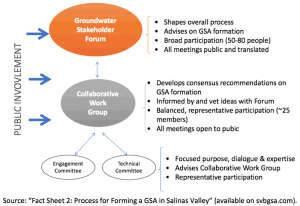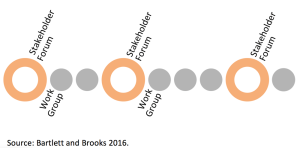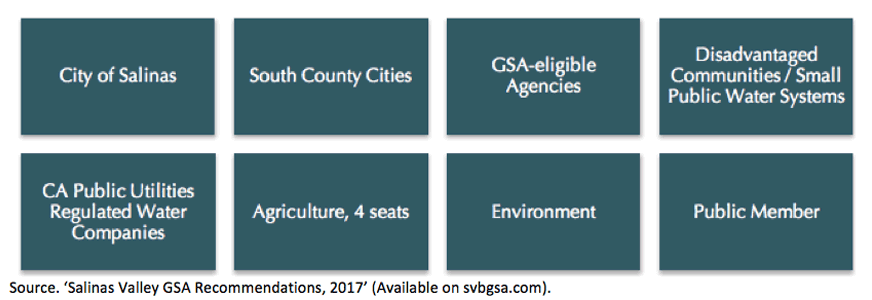Water is used for agricultural purposes, household needs, energy generation, transportation, recreation, and environmental protection. If there were an unlimited supply of high quality water available all the time, there would be no need to prioritize among these competing uses. However, as demand outstrips supply and uncertainty about how much water there will be in the future increases (due, in part, to climate change), water management will require continuous negotiation and dispute resolution to resolve competing water demands. In short, we believe that effective (and equitable) water management will require effective stakeholder engagement.
This post is a continuation of our Water Diplomacy: Issues of Complexity Science and Negotiation Theory series (see our first and third posts in this series) of the conflict over water in California, but focuses on strategies of stakeholder engagement and illustrates elements of a ‘good’ process using a case of stakeholder engagement in groundwater policymaking in the Salinas Valley Basin.
Stakeholder Engagement
Although there are many benefits to stakeholder engagement (which we will discuss later), poorly conducted stakeholder engagement processes may contribute to a democratic deficit by giving more power to individuals and groups that have more access to, or expertise in, collaborative problem solving (Swyngedouw 2000). Therefore, we believe that a critical first step in ensuring a ‘good’ stakeholder engagement process is making sure that the ‘right’ people (i.e. those directly affected by policy changes) are involved in setting the agenda for policy-making, considering available findings, facts and forecasts, and generating management options and plans.
Water managers and policymakers need to ask:
- Who are the stakeholders?
- What are their interests, and are they clearly defined?
- How will stakeholders be represented “at the table”?
- Is there a credible agreement on the relevant scientific and technical findings, facts and forecasts?
- Is there agreement on the values and ethical considerations that ought to come into play?
The number and range of stakeholders, the diversity of their interests, and the type of problem the conflict poses all have an impact on the depth and breadth of the stakeholder engagement strategy needed.
Different Types of Problems Require Different Levels of Engagement
For example, problems with high disagreement over science, but high agreement over values and norms (lower left quadrant of Figure 1) are likely to require a substantial joint fact-finding component.
These “moderately structured” problems are less likely to require a probing investigation into stakeholder interests. They may instead be approached through an advisory committee-type process that allows a smaller group of representatives to commit substantial time to familiarize themselves with potential policy responses and develop a plan.
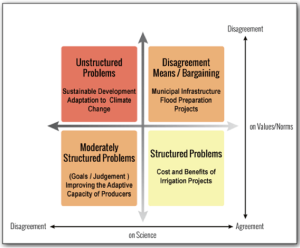
Figure 1. Four Types of Policy Problems Identified in Policy Analysis. Adaptation of Figure 1 from Hurlbert and Gupta 2015.
On the other hand, a problem with a wider gap between stakeholders’ interests and values, but with general agreement on the science (upper right quadrant), may require more involved consultation with stakeholders and broader inclusion at the negotiating table to account for divergent interests. This type of problem may have less need for joint fact-finding or expertise, because the problem and range of policy options are more defined at the outset.
Finally, for “unstructured problems” (upper left quadrant), also known as “wicked problems” (Rittel and Webber 1973), where the technical aspects, the values/norms, and the problem space itself are all contested, an approach to engagement that allows ongoing dialogue, mutual learning and the building of trust among stakeholders, as well as a flexible response is likely to be needed. In the case of California’s constrained water supply, not only do stakeholders hold divergent values regarding groundwater, but the ecosystem impacts of climate change and its effect on rates of groundwater depletion are not fully understood, leading to contention over values, science, and problem definition.
Approaches to Stakeholder Engagement
Stakeholder engagement can include a wide range of activities and techniques including surveys, town-hall meetings, focus groups, workshops, social media chat groups, in-depth individual interviews, and extended face-to-face negotiations. The approach to stakeholder engagement will depend on the type of problem. Common approaches include:
- Citizens’ Juries mimic the model of a traditional jury, in which a random sample (with some effort at representativeness) of the population deliberates with input from “expert witnesses” and other technical instruction. These typically extend over several days (Tippett, Handley, and Ravetz 2007).
- Deliberative Polling has some things in common with a citizens’ jury, but differs in that the opinions formed by a representative sample of citizens are compared with the opinions of the general public determine how deliberations may have shaped public opinion (Fishkin and Luskin 2005).
- Focus groups are one-time, “lightly facilitated” conversations among small groups selected to mirror the views of various segments of the public. These groups are often convened to determine the differences in the views of various subgroups (Rowe and Frewer 2000).
- Advisory committees are small groups selected to represent a range of views (but not necessarily to mirror the whole community). They are asked by elected or appointed officials to consider an issue of public concern. They typically meet over an extended period of time and make recommendations that officials consider as they will (Rowe and Frewer 2000).
- Devising seminars are off-the-record problem-solving sessions, managed by a professional facilitator, for the purpose of generating ideas that all the groups involved can support. Only agreements reached by consensus are reported. Participants are involved in their personal capacities and all the work is confidential (Susskind and Rumore 2015).
- Consensus building is a process, managed by a professional facilitator, that involves an inclusive set of stakeholder representatives (chosen by the groups themselves). They engage not just in discussion, but in collaborative problem-solving using a mutual gains approach to negotiation. Consensus is reached when stakeholders agree that they can live with whatever has been proposed as a result of their deliberation (Susskind, McKearnan, and Thomas-Larmer 1999). Typically, the process results in a written and signed report.
Citizens’ juries, deliberative polling and focus groups are sometimes used to determine how the general public may be leaning at a particular point in time. Because they are a one-time event and are not used to generate agreements, they reflect each party’s positions, but not what they might think after extended joint fact finding and problem-solving have been completed. Although these approaches are less time consuming and easier to implement, they do not necessarily include stakeholders in collaborative decision-making.
Devising seminars and consensus building processes, on the other hand, are more time consuming and resource intensive but allow stakeholders to try to come to a resolution through deliberation and negotiation. Given the range of possible processes and types of disputes, it is important to diagnose the conflict and design an engagement approach that is suited to it.
What is ‘good’ stakeholder engagement?
Stakeholder engagement that is done well tends to improve the quality and durability of agreements (Dietz et al. 2008; Innes and Booher 1999; Susskind and Cruikshank 1987). Even when agreement is not reached, stakeholder engagement can lead to a better understanding of the implicit conflicts (in terms of competing stakeholder interests); increased political buy-in and legitimacy of whatever is decided; relationship building among contending parties; identification of mutually agreeable management plans; and learning and change beyond the process (Innes and Booher 1999; Connick and Innes 2003).
These benefits are more likely to be achieved by establishing a good process. Innes and Booher (1999) outline a set of process criteria that they believe is crucial to any collaborative process: (i) the dialogue includes representatives of all relevant interests; (ii) it is driven by a practical purpose and task shared in the group; (iii) it is self-organizing; (iv) it is engaging to participants as they learn and interact; (v) it encourages challenges to assumptions and the status quo and fosters creativity; (vi) it incorporates many kinds of high quality information; and (vii) it seeks consensus only after discussions have fully explored issues and interests and significant effort has been made to find creative responses to differences.
However, even when these conditions are met, there is still a risk that not all relevant stakeholders will agree to participate, or that they will not be sufficiently informed to help produce decisions that are in the public interest. Furthermore, more politically powerful stakeholders/interests (i.e., those with more money or lobbying power) may drown out the weaker voices, undermining the ‘fairness’ of the outcome.
While these are all legitimate concerns, a ‘good’ process – one that begins with a careful stakeholder assessment (Box 1) prepared by a neutral party, provides ongoing support for stakeholders who need technical assistance, and is managed by a professional facilitator – can overcome these challenges.
What does ‘good’ stakeholder engagement look like in practice?
After three years of drought, the State of California passed the Sustainable Groundwater Management Act (SGMA) in 2014. The goal was to enumerate and assign groundwater management responsibilities at the local level. Although there are past examples (Box 2) of stakeholder engagement in water policymaking in California, SGMA is considered ‘more than a novel experience’ by some because it arguably ‘has the potential to transform the state from having a system of groundwater management that is among the most deficient in the country to having a set of locally inclusive governance systems that will achieve long-term groundwater sustainability’ (Kiparsky et al. 2016).
SGMA identified 127 high- and medium-priority basins in critical overdraft (Figure 2) in California based on population, public supply well distribution, irrigated acreage, reliance on groundwater as the primary source of water and other variables (CADWR 2014).
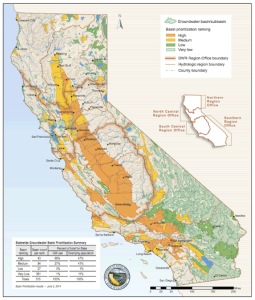
Figure 2. California Groundwater Basin Prioritization. Source: California Department of Water Resources
At the time, the basins were using approximately 96 percent of the state’s groundwater and supporting 88 percent of the population (Moran and Wendell 2015). SGMA was aimed at avoiding groundwater overdraft and making sure that the interests of “all beneficial uses and users of groundwater” were taken into account in local water management. SGMA’s approach was to ensure state-wide groundwater sustainability by: (i) respecting regional differences and providing for a tailored approach to planning; (ii) establishing minimum standards for sustainable groundwater management; (iii) improving coordination between land use and groundwater planning; (iv) providing state technical assistance; (v) creating a mechanism for state intervention if, and only if, a local agency is not managing its groundwater sustainably; and (vi) protecting water rights (CADWR 2015).
In summary, the State would provide assistance and ensure compliance, but allow basins to form their own governance agencies and develop their own sustainability plans. SGMA outlined three major phases for implementation: Phase I: Groundwater Sustainability Agency (GSA) Formation by June 30, 2017; Phase II: Development of a Groundwater Sustainability Plan (GSP) by 2020/2[i]; and Phase III: Implementation of the Plan by the GSA twenty years after adoption of the plan. All 127 high- and medium-priority basins were required to establish a GSA composed of one agency or a group of agencies (Phase I).
GSA composition was contentious because it could influence which water uses would be prioritized in the future Groundwater Sustainability Plans. For example, in the case of Salinas Valley Basin, although some stakeholders believed the existing Water Resources Agency to be the best-positioned agency to become the GSA, others felt it would prioritize agricultural over urban interests, and therefore pushed for a GSA with multiple agencies that could represent a wider range of interests (Bartlett and Brooks 2016). The best way to ensure that GSA composition would adequately represent stakeholder interests was through a consensus-building process facilitated by a professional neutral.
GSA Formation Process in Salinas Valley, California
This post highlights the stakeholder engagement process used to form the Salinas Valley Basin GSA. Salinas Valley is located within Monterey County in northern California. It is one of the most productive agricultural regions in California.
In Summer 2015, a Consortium of stakeholders from the Salinas Valley Basin asked the not-for-profit Consensus Building Institute (CBI) to facilitate a consensus-building process to help formulate a GSA. The experience of the facilitators holds lessons that can be useful to anyone using stakeholder engagement to inform policy. Namely, preparation is crucial, engage all stakeholders and co-design an engagement process that fits the type of problem.
Preparation is Crucial: Stakeholder assessments are time consuming and costly, but conducting a good assessment is critical to designing an effective consensus building approach.
The facilitators from CBI started by setting a budget with the convener (in this case, the Consortium) and outlining a first round of interviews with the ‘obvious’ stakeholders. This first round included representatives of the water management agencies, cities, environmental and conservation groups, agriculture, public health departments, and public works. The interviews often lasted close to an hour and included questions about stakeholders’ interest in groundwater; GSA formation and structure; process and decision-making; internal decision making; and stakeholder engagement (Bartlett and Brooks 2016, Appendix B).
At the end of every interview, the facilitator asked the interviewee to suggest any stakeholders who may not have been captured in the first round. After several rounds of interviews, the facilitators realized that they were not gaining any new information – either in terms of interests or additional stakeholders – and concluded the stakeholder assessment process. In total, they conducted 35 in-depth interviews with 47 individuals and received 86 individual surveys from a broad range of stakeholders over a period of two months. In general, stakeholder assessments can take between 6 weeks to four months, depending on the number of stakeholders involved and complexity of the case.
Once the assessment was completed, the facilitators shared the results of the stakeholder assessment with the convener and the stakeholders in the form of a presentation and report. Every interest was captured without attribution – this is important both in terms of building the stakeholders’ trust in the process and in helping parties focus on issues rather than on the individuals involved. In some instances, the facilitator may also organize public meetings to share the results of the stakeholder assessment with the general public for more feedback.
Engage All Stakeholders: It is not easy to engage every stakeholder. They may lack the awareness, interest, or ability to participate in participatory processes. Any engagement process should include multiple outreach strategies that ‘speak to’ a broad range of stakeholders.
In the case of Salinas Valley Basin, the facilitators had a difficult time engaging disadvantaged communities even though it was arguably in these communities’ interest to be involved in the formation of the GSA due to their heavy reliance on groundwater. Outreach to these communities, which were predominantly made up of low-income Spanish-speaking farm workers, was difficult due to the language barrier, the amorphous nature of agency-formation (rather than groundwater management itself) and the communities’ lack of trust in the government given the 2016 presidential election. Although the facilitators held public meetings with Spanish-speaking translators, very few farm workers attended. After the first public meeting, the facilitators had two options – continue the process with just those who had already ‘bought into’ the process or spend the time and resources to engage this group.
The facilitators and stakeholders decided on the latter because they believed it was crucial to the equitability of the process and outcome that these disadvantaged communities have an opportunity to shape future groundwater policy. They partnered with respected and well-known local non-governmental organizations and the public health department to raise awareness and solicit input into the consensus-building process around the formation of the GSA through small meetings, translated materials and radio interviews conducted in Spanish. Once the disadvantaged communities trusted the ‘messengers’, they were willing to engage in the process.
Co-Design a Process that Works: One benefit of conducting a stakeholder assessment is that the full range of interests are identified and can be represented, thereby reducing the need for all stakeholders to be engaged at every point in the process. It also provides an opportunity for a broad range of stakeholders to provide input on the design of the engagement process that is efficient (in terms of cost and time) and fair (in representing their interests).
In this case, the facilitators, convener and stakeholders co-designed an approach in which they met as a large group (Groundwater Stakeholder Forum) to shape the overall process, before deferring the task of drafting a proposal for the formation of the GSA to a smaller group of individuals (the Collaborative Work Group) who met more regularly (Figure 3). The Groundwater Stakeholder Forum meetings were generally attended by 50 – 80 individuals, whereas the facilitators limited the number of people in the Work Group to 20-25 people to make sure that everyone involved had all the relevant data to make informed decisions and to reduce the inherent logistical difficulties of bringing a large group together.
Once the proposal was drafted, it went through several rounds of feedback from the larger group of stakeholders (i.e. Stakeholder Forums) and editing by the Work Group (Figure 4). Although the Work Group was limited to a small number of individuals, all Work Group deliberations were open to the public.
This iterative ‘accordion approach’ (wide – narrow – wide participation) only works effectively if all interests are well represented. As such, the composition of the group is crucial. In this particular case, it took approximately two months for the facilitators to determine which individuals should be included in the Collaborative Work Group (CWG) to represent all the interests. It was particularly important to them to find effective representation for agricultural and environmental interests and strong representation for the disadvantaged communities. Eventually, they found an organization that had worked on environmental justice issues in Salinas Valley, was committed to the consensus-building approach of the collaborative work group and was able to participate throughout the process.
The Collaborative Work Group developed a consensus-based proposal for GSA formation in Salinas Valley. The proposal included a recommendation for a governing board with eleven directors who could represent public and private groundwater interests – which included urban, agricultural, and environmental interests (Figure 5).
Although agricultural interests are arguably over-represented, stakeholders engaged in the GSA formation process recognized that agriculture should have a ‘big voice’ in the final governance structure because it is the primary economic driver in the Valley (Bartlett and Brooks 2016). Furthermore, the Collaborative Work Group proposal had to be approved by the Groundwater Stakeholder Forum before it was officially adopted and submitted to the California Department of Water Resources for final approval.
The Salinas Valley GSA appointed its Board of Directors and advisory group and submitted a final Joint Exercise of Powers Agreement, which clarifies every aspect of the GSA’s governance structure, to the State of California. For example, it clarifies agencies and individuals that are eligible to serve on the Board of Directors, voting procedures, funding contributions by each Board Member for the first and second year, and a dispute resolution mechanism. The GSA is now in the process of developing its Groundwater Sustainability Plan (due by 2020).
From start (i.e. selecting a professional facilitator) to finish (GSA formation), the process took approximately two years. It remains to be seen whether or not the final plan adequately represents the diverse set of interests in the Valley but most[ii] stakeholders felt the final proposed governance structure of the GSA was reflective of their interests.
Conclusion
Stakeholder engagement in water management is time consuming and expensive. However, as illustrated by the example of Salinas Valley Basin, a professionally facilitated process that begins with a carefully conducted stakeholder assessment can help ensure that all interests are adequately met and that those affected by future groundwater policy have the opportunity to decide who will govern groundwater use.
Stakeholder engagement is not, in and of itself, the end goal. A good stakeholder engagement process begins with a carefully conducted stakeholder assessment, engages all stakeholders, is managed by a professional mediator. Not every water problem requires full stakeholder engagement. It is therefore up to the convener, facilitator and stakeholders to co-design a process that balances the need for efficiency with the need for fairness.
We thank mediators Bennett Brooks and Gina Bartlett, of the Consensus Building Institute, who conducted the stakeholder assessment and helped facilitate the Salinas Valley GSA formation process, for contributing their knowledge and perspective to this post.
Bibliography
Bartlett, Gina, and Bennett Brooks. 2016. “Salinas Valley Groundwater Stakeholder Issue Assessment.”
CADWR. 2014. “California Groundwater Elevation Monitoring Basin Prioritization Process.”
———. 2015. “Sustainable Groundwater Management Act Brochure.” California Department of Water Resources.
Connick, Sarah and Judith E Innes. 2003. “Outcomes of Collaborative Water Policy Making: Applying Complexity Thinking to Evaluation.” Journal of Environmental Planning and Management 46 (2): 177–97.
Connick, Sarah and Judith E. Innes. 2001. “Institute of Urban and Regional Development.” IURD Working Paper Series.
Dietz, Thomas and Paul C. Stern, eds. 2008. Public Participation in Environmental Assessment and Decision Making. Washington, DC: National Academies Press.
Fishkin, James and Robert Luskin. 2005. “Experimenting with a Democratic Ideal: Deliberative Polling and Public Opinion.”
Hurlbert, Margot and Joyeeta Gupta. 2015. “The Split Ladder of Participation: A Diagnostic, Strategic, and Evaluation Tool to Assess When Participation Is Necessary.” Environmental Science & Policy 50 (June): 100–113.
Innes, Judith E. and David E Booher. 1999. “Consensus-Building and Complex Adaptive Systems: A Framework for Evaluating Collaborative Planning.” Journal of American Planning Association 65 (4): 1–13.
———. 2007. “Consensus Building and Complex Adaptive Systems.” Journal of the American Planning Association 65 (4): 37–41.
Kallis, Giorgos, Michael Kiparsky and Richard Norgaard. 2009. “Collaborative Governance and Adaptive Management: Lessons from California’s CALFED Water Program.” Environmental Science and Policy 12 (6): 631–43.
Kiparsky, Michael, Dave Owen, Nell Green Nylen, Juliet Christian-Smith, Barbara Cosens, Holly Doremus, Andrew Fisher and Anita Milman. 2016. “Designing Effective Groundwater Sustainability Agencies: Criteria for Evaluation of Local Governance Options.”
Moran, Tara, and Dan Wendell. 2015. “The Sustainable Groundwater Managment Act of 2014: Challenges and Opportunities for Implementation.”
Rittel, Horst W. J. and Melvin M. Webber. 1973. “Dilemmas in a General Theory of Planning.” Policy Sciences 4 (2): 155–169.
Rowe, G. and L. J. Frewer. 2000. “Public Participation Methods: A Framework for Evaluation.” Science, Technology & Human Values 25 (1): 3–29.
Susskind, Lawrence;, and Jeffrey Cruikshank. 1987. Breaking the Impasse: Consensual Approaches to Resolving Public Disputes. Basic Books, Inc.
Susskind, Lawrence E., Sarah McKearnan, and Jennifer Thomas-Larmer. 1999. The Consensus Building Handbook: A Comprehensive Guide to Reaching Agreement. 1 edition. Thousand Oaks, Calif: SAGE Publications, Inc.
Susskind, Lawrence E., and Danya Rumore. 2015. “Using Devising Seminars to Advance Collaborative Problem Solving in Complicated Public Policy Disputes: Using Devising Seminars to Advance Collaborative Problem Solving.” Negotiation Journal 31 (3): 223–35.
Swyngedouw, Erik. 2000. “Authoritarian Governance, Power, and the Politics of Rescaling.” Environment and Planning D: Society and Space 18 (1): 63–76.
Tippett, Joanne, John F. Handley, and Joe Ravetz. 2007. “Meeting the Challenges of Sustainable development—A Conceptual Appraisal of a New Methodology for Participatory Ecological Planning.” Progress in Planning 67 (1): 9–98.
[i] High priority basins have to complete a groundwater sustainability plan by 2020, whereas medium priority basins have until 2022 to complete a plan.
[ii] Ultimately, one small city and one small water district decided to break away and form their own individual agencies.

